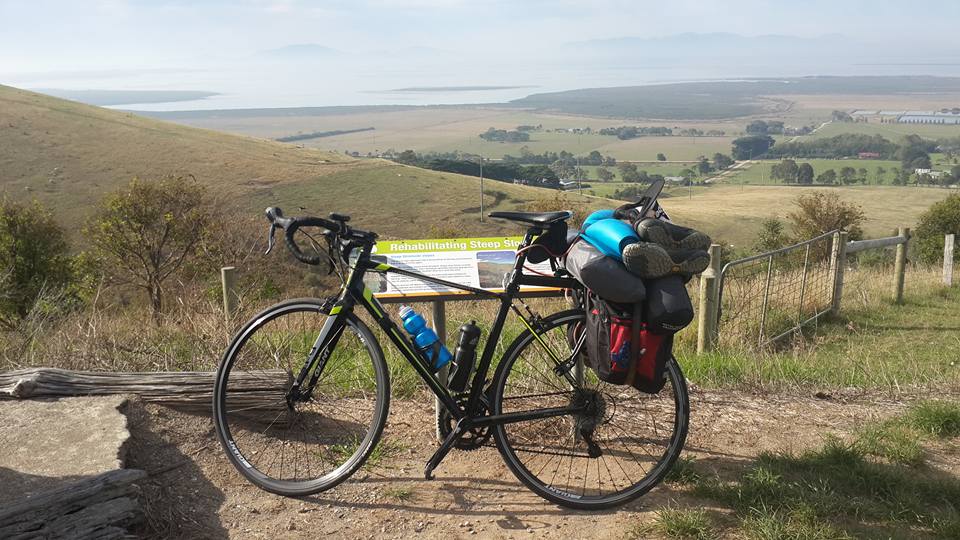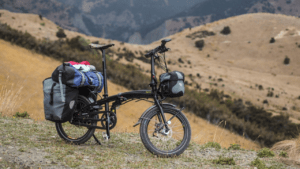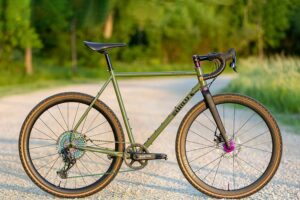Updated: 15th August 2025
Have you ever gazed longingly at those epic bike touring adventures but hesitated because you only own a road bike? You’re not alone. Many cycling enthusiasts wonder: Can a road bike be used for touring? The short answer is absolutely yes – but there’s much more to this story than a simple yes or no.
Here’s the honest truth: choosing the right bike for your touring goals can make the difference between a magical, life-changing adventure and a miserable experience that turns you off cycling forever. I learned this the hard way during my first fully-loaded tour on a road bike – cheap seatpost rack, bargain panniers, and absolutely no idea what I was doing. By day two, everything was falling apart, held together with zip ties and determination. It wasn’t pretty, and it certainly wasn’t the joyful introduction to bike travel I’d dreamed of.
But here’s what I want you to understand: while having the wrong bike can absolutely dampen your experience, don’t let bike selection paralysis stop you from exploring the world – or at least your own backyard. Sometimes the best way to discover what you truly need is to start with what you have. That disastrous first tour taught me invaluable lessons about gear, expectations, and what I actually wanted from bike travel.
The world of bicycle touring doesn’t require you to wait for the perfect setup, but it does reward thoughtful preparation. While dedicated touring bikes exist for good reasons, your trusty road bike can absolutely get you started on incredible adventures. This comprehensive guide will show you exactly how to transform your road bike into a touring-capable machine, when it makes sense to do so, and when you might want to consider alternatives.
If you’re serious about finding the perfect bike for your touring dreams, I’ve created a comprehensive Bike Buyer’s Masterclass that walks you through everything you need to know about selecting the ideal bicycle for your specific needs and adventures. Because while you can tour on a road bike, having the right tool for the job makes all the difference in how much you’ll love the experience.
Can You Put Panniers On A Road Bike?
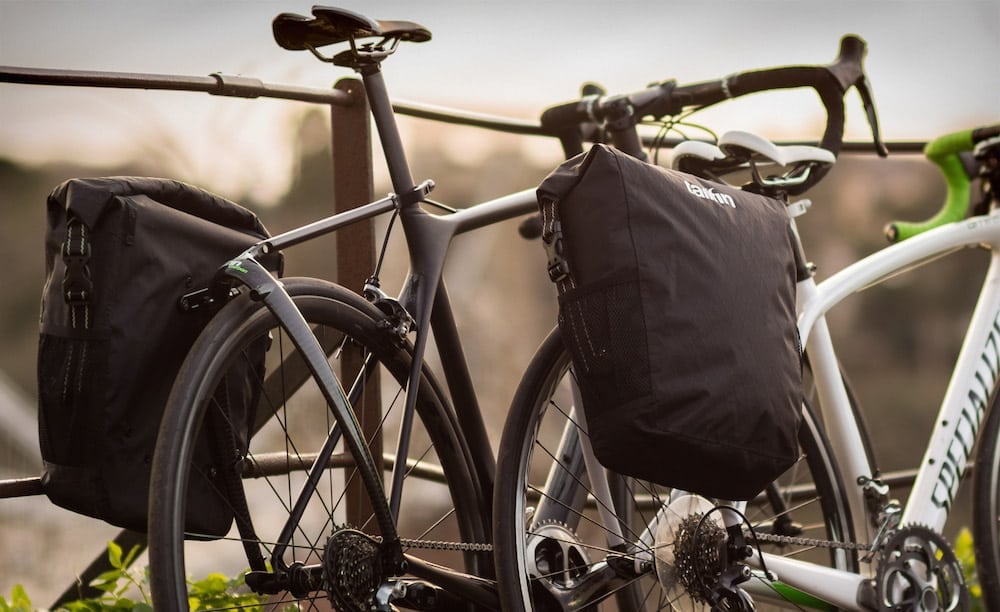
Yes, you absolutely can outfit a road bike with panniers. This is perhaps the most common question aspiring bike tourists ask, and thankfully, modern innovations have made this entirely possible.
Gone are the days when the lack of built-in rack eyelets on road bikes created insurmountable barriers. Today’s market offers ingenious solutions that have revolutionized what’s possible with road bike touring. Specialized mounting kits now allow you to securely attach racks by shifting the weight load onto the axle – a component that’s inherently designed to handle substantial loads.
These breakthrough innovations include:
- Axle-mounted rack systems that bypass the need for frame eyelets entirely
- Specialized attachment pucks that secure to the frame with ultra-durable zip ties
- Versatile seatpost collars with integrated mounting points
- Quick-release mounting systems for bikes lacking traditional eyelets
This technological evolution has dramatically expanded what you can achieve with a road bike, whether you’re planning daily commutes with cargo or embarking on multi-week touring adventures.
Understanding Road Cycling vs Touring Cycling: Key Differences
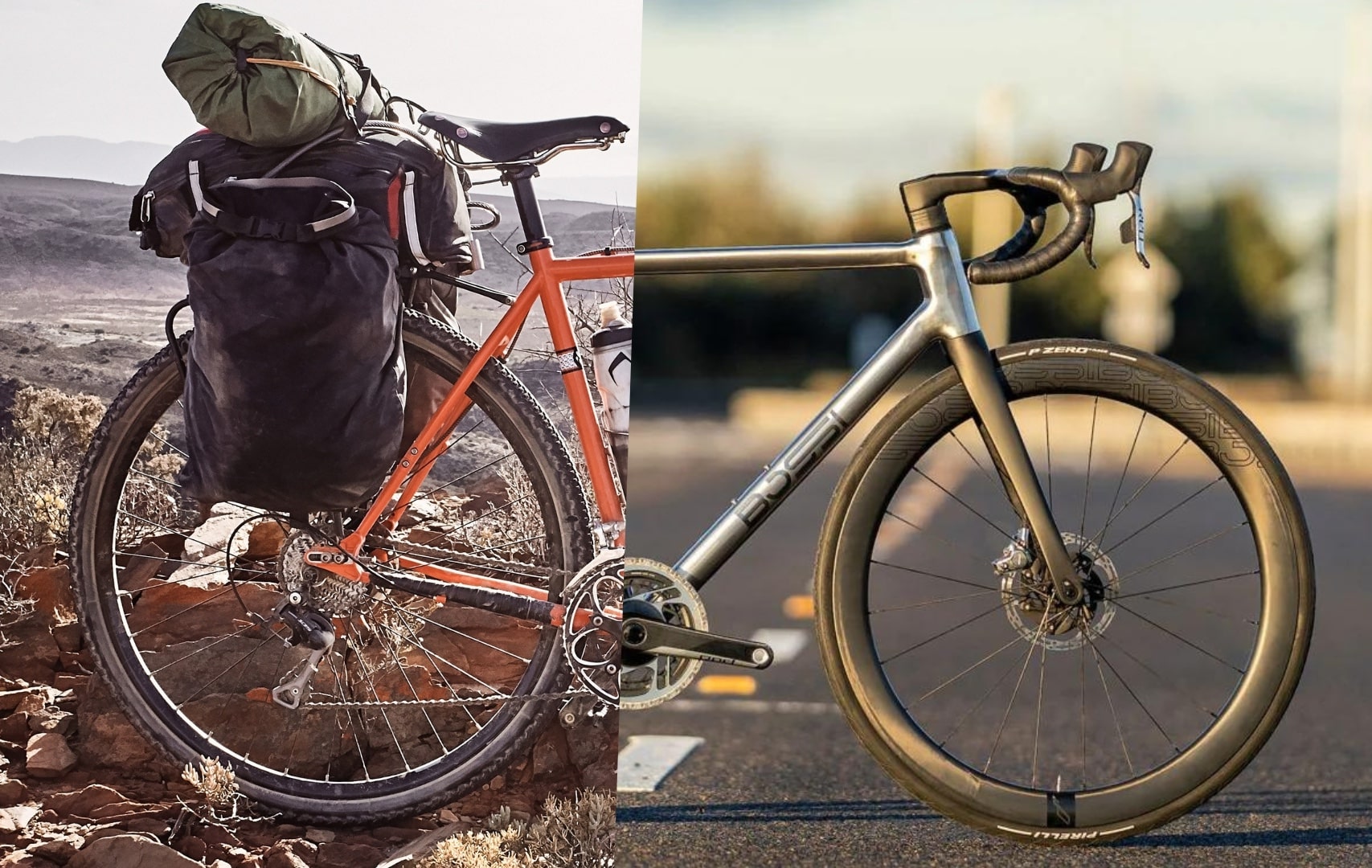
Before diving deeper into road bike touring, it’s crucial to understand the fundamental differences between road cycling and touring cycling. These distinct disciplines have evolved to serve different purposes:
Road Cycling Philosophy
Road cycling prioritizes speed, efficiency, and performance. The entire ecosystem – from bike geometry to component selection – revolves around maximizing power transfer and minimizing weight. Riders typically cover shorter distances at higher intensities, often returning home the same day.
Touring Cycling Philosophy
Touring cycling emphasizes comfort, reliability, and cargo capacity for extended journeys. Every design decision considers the realities of carrying gear for days, weeks, or months while maintaining rider comfort across varied terrain and weather conditions.
Key Philosophical Differences:
- Distance Focus: Road cycling optimizes for speed over shorter distances; touring optimizes for comfort over extended distances
- Load Considerations: Road bikes carry minimal gear; touring bikes are designed around substantial cargo loads
- Terrain Adaptability: Road bikes excel on smooth pavement; touring bikes handle diverse surfaces
- Maintenance Philosophy: Road bikes prioritize performance; touring bikes prioritize field-repairability and reliability
Understanding these differences helps explain both the challenges and opportunities when adapting a road bike for touring purposes.
The Complete Guide to Mounting Racks on Road Bikes
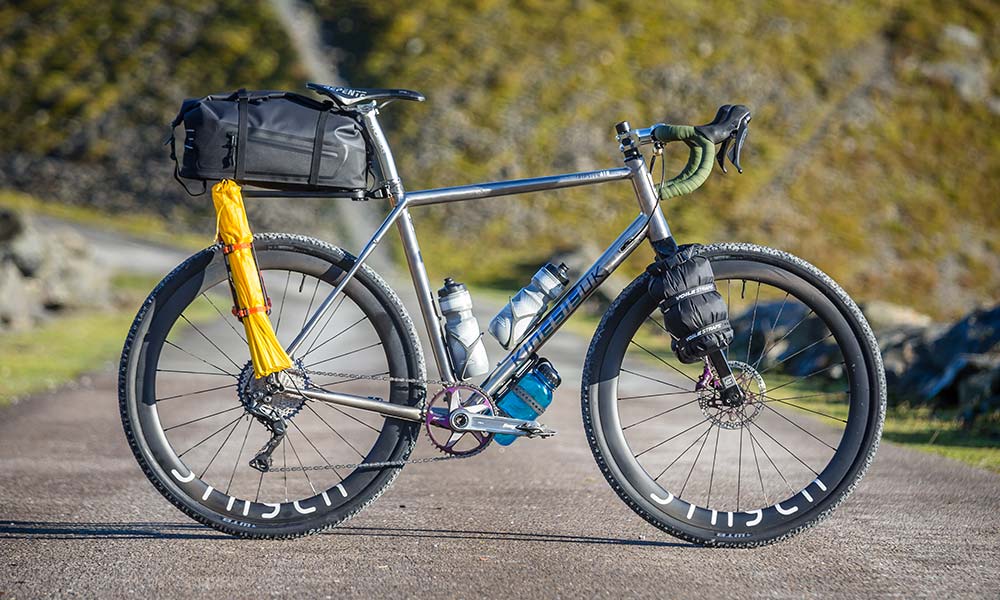
When Your Road Bike Has Eyelets
Some road bikes, particularly entry-level models from manufacturers like Trek and Giant, come equipped with rack eyelets. If your bike falls into this category, you’re ahead of the game. Standard rear racks can be mounted directly to these attachment points, giving you immediate pannier capability.
When Your Road Bike Lacks Eyelets
Don’t despair if your road bike doesn’t have eyelets – this is where innovation truly shines. Several proven solutions exist:
Old Man Mountain Fit Kits: The Game-Changer
Old Man Mountain has revolutionized rack mounting with their ingenious Fit Kits. These systems cleverly redistribute weight from the frame to the axle, transforming any bike into a rack-ready touring machine.
Key Benefits:
- Universal compatibility with nearly any bike frame
- Enhanced load capacity by utilizing the axle’s inherent strength
- Frame protection by avoiding stress concentration on frame tubes
- Professional-grade reliability tested across thousands of miles
For bikes lacking upper mounting points, Old Man Mountain’s specialized pucks attach securely using ultra-durable zip ties. Their seatpost collar systems further expand compatibility, ensuring virtually any road bike can accommodate expedition-grade racks.
DIY and Alternative Mounting Solutions
For budget-conscious cyclists or those preferring hands-on solutions, several alternatives exist:
P-Clamps: These cushioned metal loop straps offer an affordable, hardware-store solution. Available in various sizes, P-Clamps install easily by clamping over fork blades or seat stays. While reliable, they’re best suited for lighter loads and shorter tours.
Tubus Stay Mounting Clamps: Specifically engineered for Tubus racks, these clamps provide a more refined alternative to generic P-clamps, offering better integration with high-quality rack systems.
Seatpost Clamps with Rack Eyelets: Some manufacturers produce racks designed specifically for road bikes using specialized seatpost clamps with integrated eyelets. While functional, these systems concentrate significant weight on the seatpost, potentially creating handling issues.
Quick Release Rack Mounting Kits: These innovative systems allow rack installation on bikes lacking lower eyelets, utilizing quick-release mechanisms for added convenience and flexibility.
Top Rack Recommendations for Road Bikes
Old Man Mountain Divide Rack: The Gold Standard
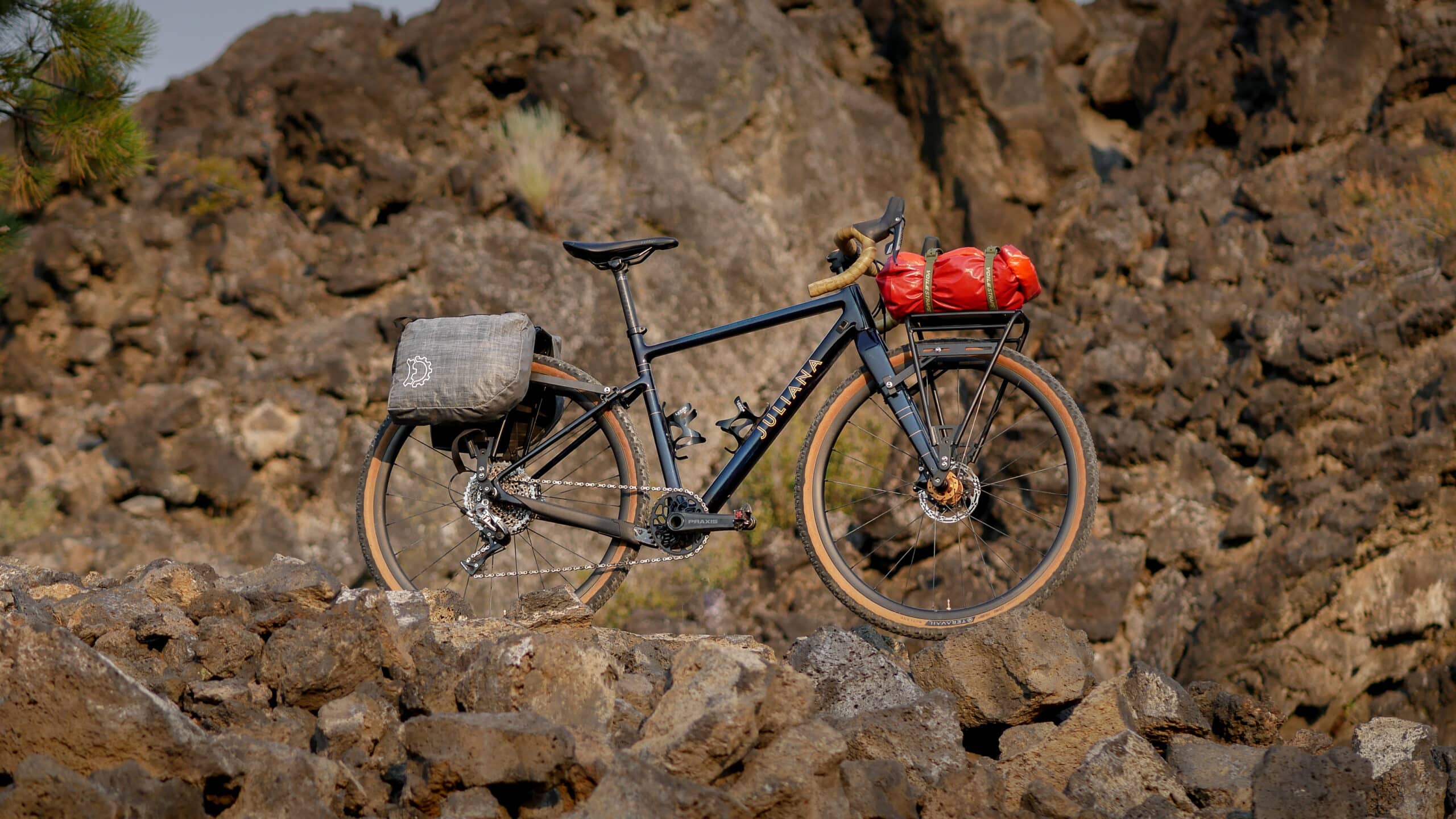
The Old Man Mountain Divide Rack represents the pinnacle of road bike rack engineering. Its innovative Fit Kit system enables axle mounting, making it compatible with virtually any bike while offering several key advantages:
Technical Specifications:
- Weight capacity: 70 pounds
- Mounting system: Axle-mounted with frame protection
- Pannier rail design: Low-profile for improved handling
- Compatibility: Universal with Fit Kit system
Key Advantages:
- Enhanced bike handling through lower center of gravity
- Superior weight distribution reducing frame stress
- Easy gear access without pannier removal
- Professional reliability proven across expeditions worldwide
The low pannier rail design is particularly beneficial for road bikes, as it improves stability and handling – crucial considerations given road bikes’ inherently quick-steering geometry.
Tailfin Racks: Lightweight Performance Options
Tailfin offers innovative pannier rack solutions specifically designed for road bikes, with both carbon and alloy options:
Carbon Rack Options:
- Weight: Starting at 257g
- Configuration: Available with or without pannier mounts
- Target use: High-performance bikepacking and light touring
Alloy Rack Options:
- Weight: Starting at 409g
- Durability: Enhanced robustness for heavier loads
- Versatility: Accommodates various bag types and sizes
Tailfin’s emphasis on innovation combines performance, convenience, and style, making them excellent choices for cyclists prioritizing weight savings without sacrificing functionality.
Can a Road Bike Be Used for Touring? The Honest Assessment
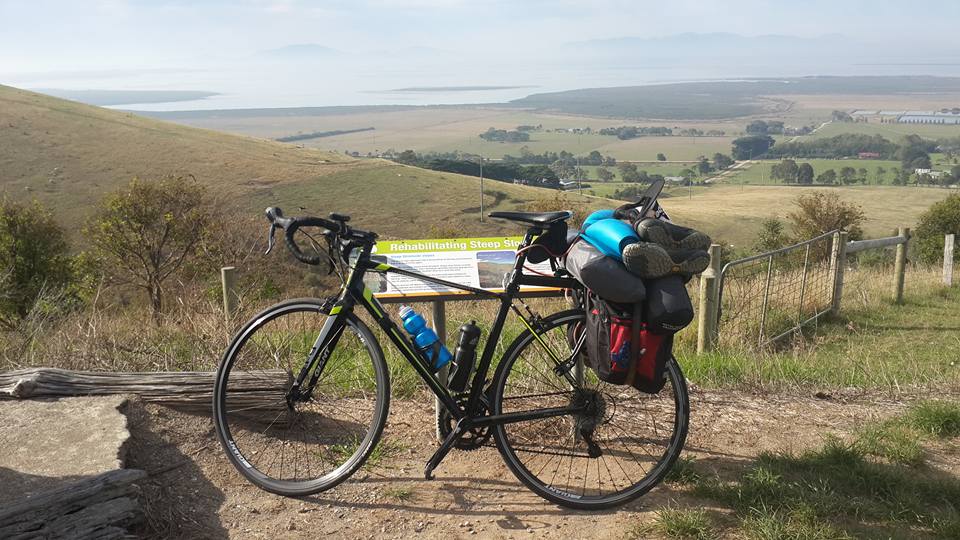
The answer is nuanced and depends heavily on your touring goals, experience level, and willingness to work within certain limitations.
When Road Bike Touring Makes Sense
Light Touring and Credit Card Adventures: For tours involving hotel stays, restaurant meals, and minimal gear, road bikes excel. Their speed advantage allows you to cover more distance with less effort, while reduced gear requirements minimize the bike’s limitations.
Getting Started in Bike Touring: Using your existing road bike represents an excellent entry point into touring. Rather than waiting for the “perfect” setup, starting with what you have builds experience and helps you understand your preferences before investing in specialized equipment.
Bikepacking Style Adventures: Modern bikepacking techniques align well with road bike capabilities. Using frame bags, seat packs, and handlebar bags distributes weight effectively while maintaining the bike’s essential handling characteristics.
When Road Bike Touring Becomes Challenging
Fully-Loaded Expeditions: Multi-week or multi-month tours requiring camping gear, cooking equipment, and extensive clothing present significant challenges for road bikes. The weight and volume requirements often exceed what road bike frames and components can comfortably handle.
Rough Terrain and Unpaved Roads: Road bikes’ narrow tires, aggressive geometry, and lightweight construction struggle on rough surfaces, especially when loaded with gear.
Mechanical Reliability Concerns: Road bike components aren’t designed for the sustained stress of heavy loads over extended periods, potentially leading to more frequent mechanical issues in remote areas.
Converting Your Road Bike to Touring: A Comprehensive Approach
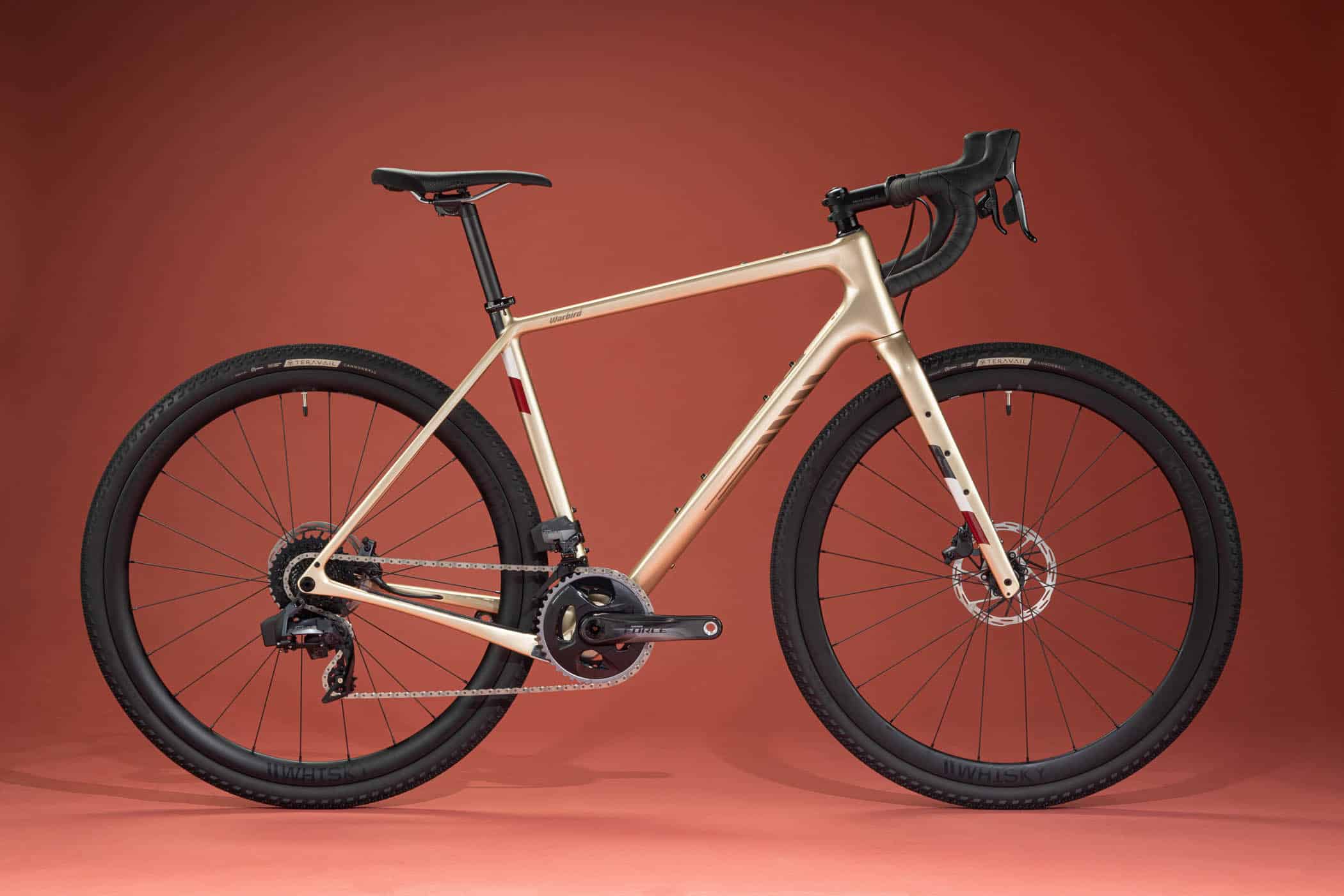
While road bikes aren’t purpose-built for touring, strategic modifications can dramatically improve their touring capability. Here’s how to convert your road bike to touring specification:
Essential Tire Upgrades
Width Considerations: Replace narrow road tires with the widest tires your frame clearance allows. Wider tires provide:
- Improved comfort through lower pressure capability
- Enhanced puncture resistance crucial when carrying extra weight
- Better grip on varied surfaces
- Increased durability for extended use
Tire Selection Criteria:
- Puncture protection: Look for reinforced casings and protective layers
- Tread pattern: Choose designs balancing road efficiency with off-road capability
- Pressure range: Select tires allowing lower pressures for comfort
Gearing Modifications for Loaded Touring
Road bikes typically feature high gear ratios optimized for speed on flat terrain. Touring with loaded panniers, especially in hilly areas, demands lower gearing options.
Cassette Upgrades: Replace your road cassette with a wider-range option. Modern 11-speed and 12-speed cassettes offer remarkable range, with some extending to 32T or even 36T large cogs.
Compact or Sub-Compact Cranksets: Consider replacing standard road chainrings with compact (50/34T) or sub-compact (48/32T) options for easier climbing with loads.
Derailleur Considerations: Ensure your rear derailleur can accommodate larger cassette cogs, potentially requiring upgrades for optimal shifting performance.
Comfort and Ergonomic Improvements
Saddle Selection: Long-distance comfort requires saddles designed for extended use rather than racing performance. Look for:
- Appropriate width matching your sit bone measurement
- Adequate padding without being overly soft
- Pressure relief through cutouts or channels
- Durability for extended use
Handlebar Modifications: Consider these options for improved comfort:
- Bar tape upgrades with enhanced cushioning
- Handlebar extensions providing additional hand positions
- Alternative handlebar shapes like compact drops or adventure bars
- Bar ends for touring-style hand positions
Frame Bags and Bikepacking Integration
Modern bikepacking on a road bike represents an elegant solution to traditional touring limitations. Strategic use of frame bags, seat packs, and handlebar bags provides substantial carrying capacity while maintaining bike handling characteristics.
Frame Bag Benefits:
- Low center of gravity maintaining stable handling
- Easy access to frequently needed items
- Weather protection for sensitive gear
- Weight distribution reducing stress on contact points
Seat Pack Advantages:
- Large volume capacity for bulky items like sleeping bags
- Aerodynamic profile minimizing wind resistance
- Frame stress reduction compared to rear racks
- Quick attachment/removal for security
Why Traditional Touring Bikes Exist: Understanding the Limitations
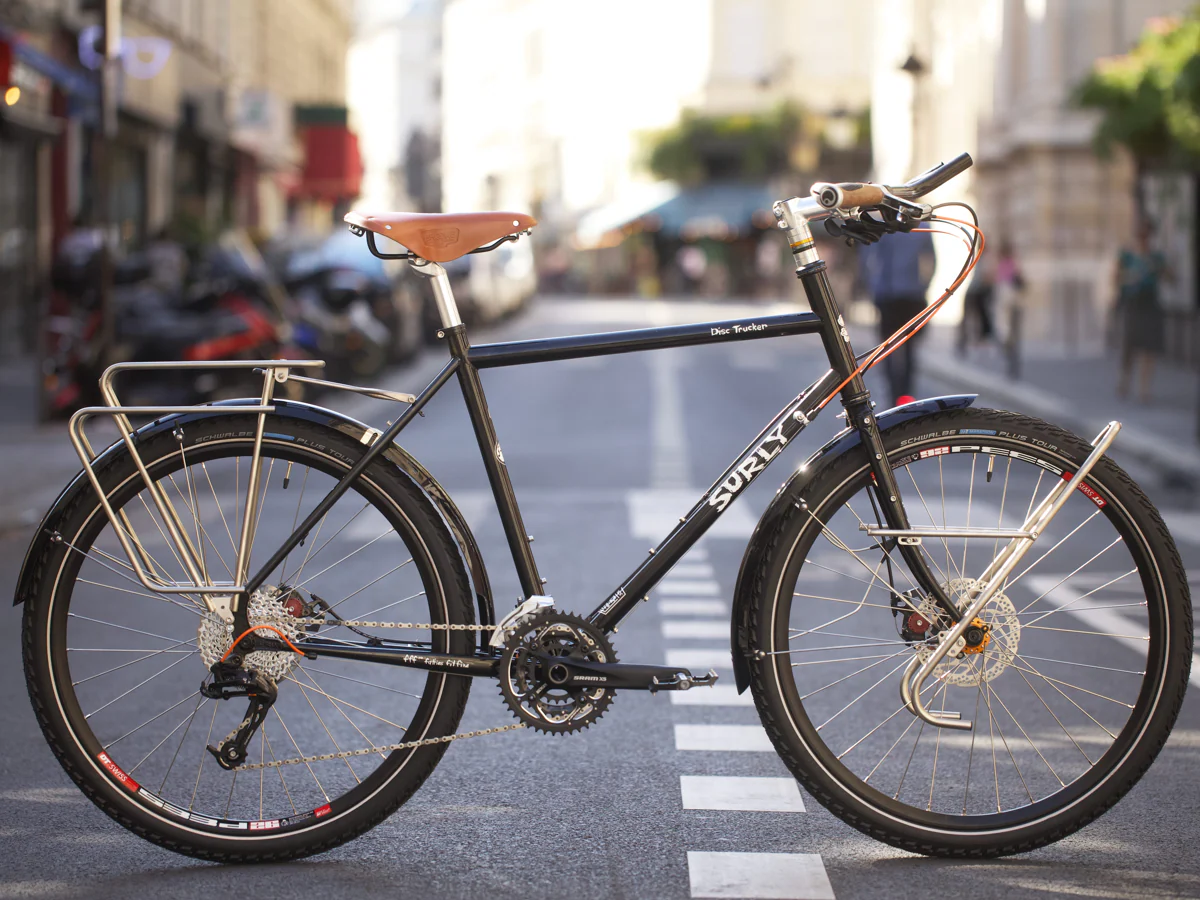
While road bikes can certainly be adapted for touring, understanding why purpose-built touring bikes exist helps set realistic expectations.
Geometry Challenges
Stack and Reach Ratios: Road bike geometry positions riders in aggressive, aerodynamic postures optimized for power output and speed. Touring demands more upright positions for comfort during extended periods.
Chainstay Length: Road bikes typically feature 405-415mm chainstays compared to touring bikes’ 435-450mm. This shorter length creates heel clearance issues with larger panniers and affects bike stability under load.
Wheelbase Implications: Shorter wheelbases make road bikes feel nimble and responsive unloaded but can create instability when heavily loaded, especially in crosswinds or on technical terrain.
Trail Measurements: Road bikes use shorter trail measurements for quick steering response – less desirable when carrying front loads that can make handling feel unpredictable.
Structural Limitations
Frame Strength: Road bike frames prioritize weight savings and stiffness for power transfer rather than load-carrying capability. Extended touring with heavy loads can stress frames beyond their design parameters.
Wheel Durability: Road bike wheels typically feature fewer spokes and lighter rims optimized for minimal weight rather than load-carrying strength. Touring demands wheels capable of handling sustained heavy loads without reliability issues.
Component Longevity: Road bike components are optimized for performance rather than durability, potentially leading to more frequent maintenance and replacement needs during extended tours.
Comfort Considerations
The aggressive positioning and stiff frames that make road bikes efficient for racing can become uncomfortable during long touring days. This discomfort isn’t just about preference – it can lead to:
- Chronic pain in back, neck, and wrists
- Reduced enjoyment of the touring experience
- Earlier fatigue limiting daily distances
- Long-term injury risk from sustained poor positioning
The N-1 Rule for Bikes: Understanding Cycling’s Inside Joke

Cyclists often reference the N-1 rule for bikes, though this represents more of a philosophical approach than practical advice. The traditional cycling joke states that the ideal number of bikes to own is N-1, where N equals the number that would cause your significant other to leave you.
In the context of road bike touring, this rule highlights an important reality: rather than purchasing multiple specialized bikes for different purposes, maximizing the versatility of your existing road bike often represents the most practical approach.
Practical Applications of N-1 Philosophy:
- Versatility over specialization when starting in cycling
- Learning your preferences before investing in specialized equipment
- Budget-conscious approach to cycling adventures
- Space-efficient for urban cyclists with storage limitations
However, as your touring ambitions grow, you may find that the limitations of adapting a road bike eventually justify investing in purpose-built equipment.
Optimizing Your Road Bike Touring Setup
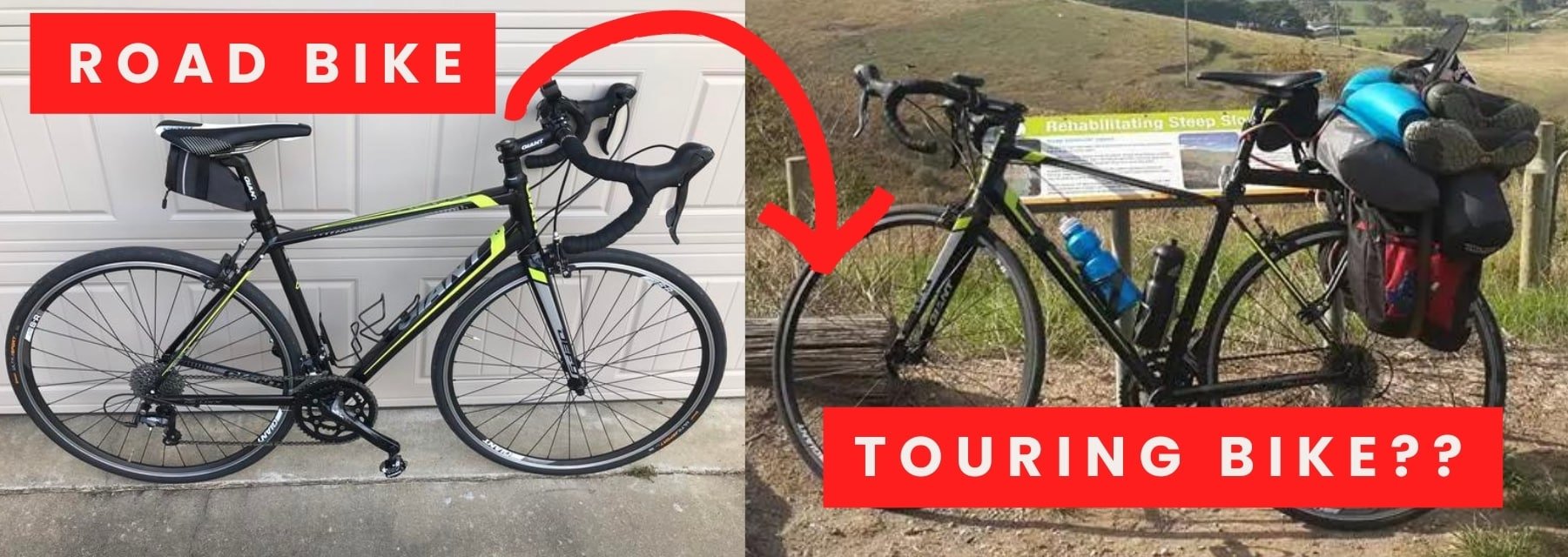
Mastering Weight Distribution
Successful road bike touring requires meticulous attention to weight distribution. Unlike purpose-built touring bikes designed around heavy rear loads, road bikes perform better with weight distributed across multiple attachment points.
Strategic Load Distribution:
- Front panniers or handlebar bags: 20-25% of total weight
- Frame bags: 15-20% of total weight
- Rear panniers or seat pack: 55-60% of total weight
- Body-carried items: Minimal emergency supplies only
Avoiding Common Mistakes:
- Excessive rear loading creating handling instability
- High-mounted loads raising the center of gravity
- Uneven side-to-side distribution affecting bike balance
- Poorly secured items that shift during riding
Choosing Appropriate Panniers and Bags
Micro Panniers for Road Bikes: Traditional touring panniers often prove too large for road bike applications. Micro panniers offer several advantages:
- Better heel clearance with shorter chainstays
- Reduced sail area in crosswinds
- Lower weight encouraging minimalist packing
- Improved aerodynamics for speed maintenance
Bikepacking Bag Integration: Modern bikepacking bags offer excellent road bike compatibility:
- Seat packs: Large capacity without frame stress
- Frame bags: Optimal weight distribution and accessibility
- Top tube bags: Perfect for frequently accessed items
- Handlebar bags: Additional storage without affecting handling
Essential Packing Strategies
Lightweight Gear Selection: Every ounce matters more on a road bike than a dedicated touring bike. Prioritize:
- Ultralight camping gear if camping is necessary
- Versatile clothing serving multiple purposes
- Minimal cooking equipment or focus on no-cook meals
- Digital maps and guides replacing heavy paper alternatives
Strategic Item Placement:
- Heavy items low and centered for optimal handling
- Frequently used items in easily accessible locations
- Emergency supplies distributed across multiple locations
- Valuable items in secure, hard-to-access positions
Alternative Approaches: When to Consider Other Options
Gravel Bikes: The Modern Middle Ground
Fast-racing gravel bikes offer an intriguing compromise between road bike speed and touring capability. These bikes provide:
Speed Advantages: Maintained efficiency on paved surfaces while offering versatility for varied terrain.
Improved Touring Geometry: More relaxed positions than road bikes while remaining performance-oriented.
Enhanced Tire Clearance: Accommodation for wider, more comfortable tires suitable for loaded riding.
Integrated Storage Solutions: Many gravel bikes include mounting points and design considerations for bikepacking setups.
Dedicated Touring Bikes: When Specialization Makes Sense
For cyclists planning extensive touring or those finding road bike limitations restrictive, dedicated touring bikes offer purpose-built advantages:
Budget-Friendly Options: Quality touring bikes are available under $1,000, often representing better value than extensively modifying a road bike.
Immediate Capability: No modification or adaptation period required – ready for adventure immediately.
Optimal Geometry: Designed specifically for loaded riding comfort and stability.
Integrated Features: Built-in mounting points, appropriate gearing, and durable components standard.
Bikepacking on a Road Bike: The Modern Solution

Bikepacking on a road bike represents perhaps the most elegant solution to traditional touring limitations. This approach leverages modern bag technology to maximize carrying capacity while preserving road bike handling characteristics.
Essential Bikepacking Bag Categories
Seat Packs: These large-capacity bags attach behind the saddle, providing substantial storage for bulky items like sleeping bags and extra clothing. Modern designs maintain aerodynamic profiles while offering impressive volume.
Frame Bags: Custom or universal frame bags utilize the main triangle space for tools, food, and other essentials. This placement offers the ideal weight distribution for maintaining bike handling.
Handlebar Bags: Ranging from small accessory pouches to large dry bags, handlebar bags provide easily accessible storage for navigation tools, snacks, and weather gear.
Top Tube Bags: Small bags along the top tube offer perfect storage for frequently accessed items like phones, snacks, or tools.
Bikepacking Advantages for Road Bikes
Maintained Aerodynamics: Well-designed bikepacking setups minimize wind resistance compared to traditional panniers.
Preserved Handling: Weight distribution maintains road bike handling characteristics rather than fundamentally altering them.
Versatility: Bags can be easily removed for day rides or different adventure styles.
Modularity: Build your storage system gradually, adding bags as needs evolve.
Real-World Experience: Learning from the Road
Personal experience often provides the most valuable insights. Many cyclists begin their touring journey on road bikes, learning valuable lessons that inform future equipment decisions.
Common Challenges and Solutions
Mechanical Issues: Road bike components under touring stress may require more frequent attention. Carry comprehensive tools and learn basic maintenance skills.
Comfort Problems: Extended riding in aggressive positions creates discomfort. Take frequent breaks and consider comfort modifications.
Handling Difficulties: Loaded road bikes handle differently than expected. Practice with your full setup before embarking on major tours.
Gear Limitations: Storage space constraints force difficult packing decisions. Embrace minimalism and prioritize multi-purpose items.
Valuable Lessons Learned
Start Small: Begin with shorter tours to understand your bike’s capabilities and limitations without committing to extended adventures.
Invest Gradually: Rather than immediately purchasing expensive modifications, identify the most impactful improvements through experience.
Embrace Constraints: Working within road bike limitations often leads to creative solutions and valuable skills.
Plan Appropriately: Choose routes and accommodations matching your equipment capabilities rather than forcing inappropriate applications.
Making the Decision: Road Bike Touring vs. Alternatives
When Road Bike Touring Makes Perfect Sense
- Limited budget for additional bike purchases
- Storage constraints preventing multiple bike ownership
- Occasional touring rather than frequent adventures
- Light touring and credit card adventures matching road bike capabilities
- Learning and exploration phase before committing to specialized equipment
When to Consider Alternatives
- Frequent touring plans justifying specialized equipment investment
- Challenging terrain or conditions exceeding road bike capabilities
- Comfort priorities outweighing speed advantages
- Mechanical reliability concerns in remote areas
- Load requirements exceeding practical road bike capacity
Your Road Bike Adventure Awaits (But Choose Wisely)
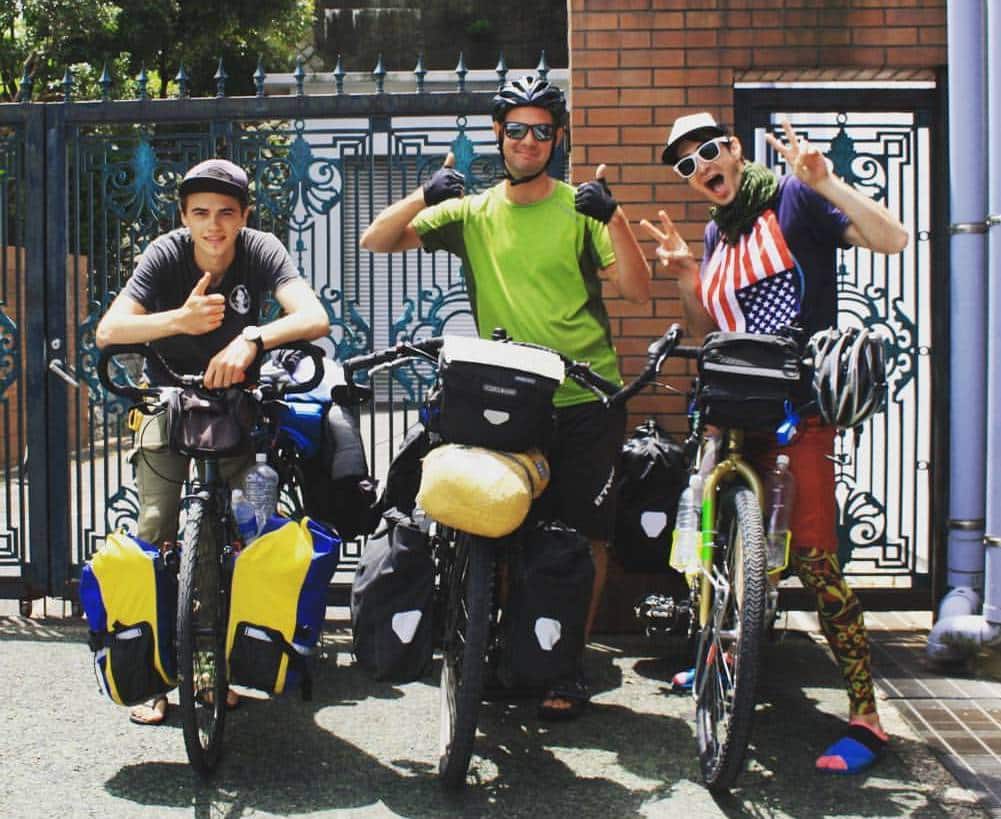
The question “Can you put panniers on a road bike?” opens the door to a much larger conversation about adventure, adaptability, and making the most of what you have. The definitive answer remains yes – modern innovations have made road bike touring not just possible, but genuinely enjoyable for many applications.
But let me be completely honest with you: the bike you choose can profoundly impact whether you fall in love with bike travel or never want to touch a bicycle again. My first fully-loaded tour was a masterclass in what not to do – heavy panniers swaying on a flimsy seatpost rack, a road bike geometry that had me hunched over in pain, and gear that literally fell apart. It was miserable, and it took years before I gave bike touring another chance.
Here’s what I wish someone had told me then: bike travel is absolutely magical when you have the right setup, but potentially miserable when you don’t. The wrong bike can turn what should be a joyful exploration into a test of endurance that has nothing to do with the beauty of slow travel.
That said, don’t let the pursuit of perfection paralyze you. Sometimes you need to get out there with what you have, make mistakes, and learn what you actually need. My disaster tour taught me more about my preferences than any amount of research could have. Just be prepared for potential challenges, start small, and view it as valuable learning rather than your ultimate bike travel experience.
Road bike touring represents an accessible entry point into the world of bicycle adventure, particularly for light touring and bikepacking-style expeditions. The key lies in matching your bike choice to your touring ambitions – weekend credit card tours work beautifully on road bikes, while months-long expeditions through challenging terrain demand different tools.
Whether you choose traditional panniers with innovative mounting solutions or embrace modern bikepacking techniques, your road bike can open doors to incredible adventures. Start where you are, use what you have, but also be honest about the limitations. Let your initial experiences guide future equipment decisions rather than forcing inappropriate applications.
If you’re ready to dive deeper into finding the perfect bike for your touring dreams, check out our comprehensive Bike Buyer’s Masterclass. Because while you absolutely can tour on a road bike, having a bicycle that’s truly matched to your goals transforms bike travel from an endurance challenge into the life-changing adventure it’s meant to be.
The cycling community’s N-1 rule reminds us that the best bike for touring is often the one you already own and are willing to ride. Your road bike adventure story begins with that first loaded ride – everything else is just refinement along the way. But remember: the goal isn’t just to survive your tour, it’s to fall so deeply in love with bike travel that you can’t imagine life without it.
The world is waiting to be explored, whether that’s distant countries or hidden gems in your own backyard. Your road bike might be the perfect introduction to that world, or it might teach you exactly what you need in your next bicycle. Either way, it’s a step toward adventure – and that’s always worth taking.
The only question remaining is: where will your first tour take you?

